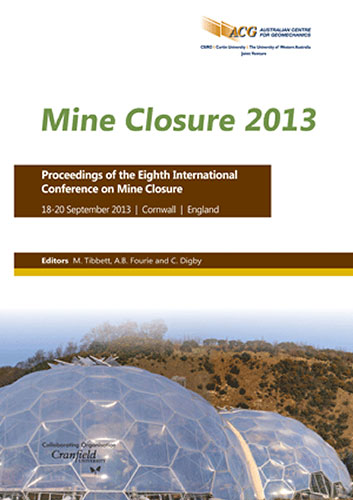Assessing and managing the long-term risks and liabilities at a closed Cornish mine used for waste disposal

|
Authors: Hobbs, SL |
DOI https://doi.org/10.36487/ACG_rep/1352_43_Hobbs
Cite As:
Hobbs, SL 2013, 'Assessing and managing the long-term risks and liabilities at a closed Cornish mine used for waste disposal', in M Tibbett, AB Fourie & C Digby (eds), Mine Closure 2013: Proceedings of the Eighth International Seminar on Mine Closure, Australian Centre for Geomechanics, Cornwall, pp. 509-522, https://doi.org/10.36487/ACG_rep/1352_43_Hobbs
Abstract:
During World War II, a large number of new airfields were established across the UK, one of which was at Portreath on the north coast of Cornwall, some 5 km from the town of Redruth. During the Cold War the site was known as Nancekuke and was used by the Chemical Defence Establishment (CDE) for research and development into chemical warfare agents, with the CDE facility eventually being closed in the late 1970s. When the plant was closed it was fully decontaminated and dismantled, and the wastes were placed in five on-site dumps, two of which were mine shafts associated with Wheal Sally, a former lead and zinc mine also known as Sally’s Bottom Mine, which closed in the 1920s. Assessment of the potential for the waste disposal to impact the environment and cost-effective options for managing this potential commenced in the late 1990s. A comprehensive desk-based evaluation of the mine system was therefore undertaken and an inspection programme formulated, consisting of aboveground drilling and closed-circuit television inspections and belowground inspections, including substantial stabilisation works. In parallel with the inspection, a monitoring programme was formulated to establish water quality conditions and the potential for the wastes to impact them. No significant risk to the environment was identified, but long-term management options were evaluated, including the cost benefit associated with each. The final solution included capping three mine shafts for health and safety reasons, using a bespoke system at one shaft to avoid excavation into wastes, and ongoing monitoring of mine discharge water that is scheduled to continue until 2020 and will then cease if, as is currently the case, no pollution has been identified.
References:
Chemical Defence Establishment (1980) Closure of CDE Nancekuke, Technical Memorandum No. 8, available in SKM, 2011.
Cornwall County Council (1998) Report to Kerrier District Council Shaft Capping Contract 11, Archaeological Assessment.
Cornwall County Council Archive Department (various dates circa 1800-1920) Abandoned mine plans MRO 200, 202C, DDX 560/29 and DDM172.
Dines, H.G. (1956) The Metalliferous Mining Region of South-West England, Memoir of the Geological Survey of Great Britain.
Enviros (2007) RAF Portreath Part 2A Voluntary Inspection, Wheal Sally Mine Adit Inspection – Final, Prepared for Defence Estates, Project No. 11774, available in SKM, 2011.
Enviros (2009) RAF Portreath Part 2A Voluntary Inspection, Dump D and the Ladderway Shaft Remedial Options Study – Final, Prepared for Defence Estates, Project No. 11774, available in SKM, 2011.
Leveridge, B.E., Holder, M.T. and Goode, A.J.J. (1990) Geology of the Country around Falmouth, Memoir for 1:50,000 Geological Sheet 352 (England and Wales), HMSO, London.
NRA (National Rivers Authority) (1992) Water Quality Investigations at Nancekuke, Cornwall, Ref:WQP/92/002, available in SKM, 2011.
SKM Enviros (2011) RAF Portreath Closure Report, prepared for Defence Estates, Project No. 11774, available via Cornwall Council and the Environment Agency (Exeter).
Watson, A.J., Farmer, T.P. and Court, M.E. (1999) RAF Portreath Land Quality Assessment, Phase 1 – Desk Study, available in SKM, 2011.
© Copyright 2024, Australian Centre for Geomechanics (ACG), The University of Western Australia. All rights reserved.
View copyright/legal information
Please direct any queries or error reports to repository-acg@uwa.edu.au
View copyright/legal information
Please direct any queries or error reports to repository-acg@uwa.edu.au